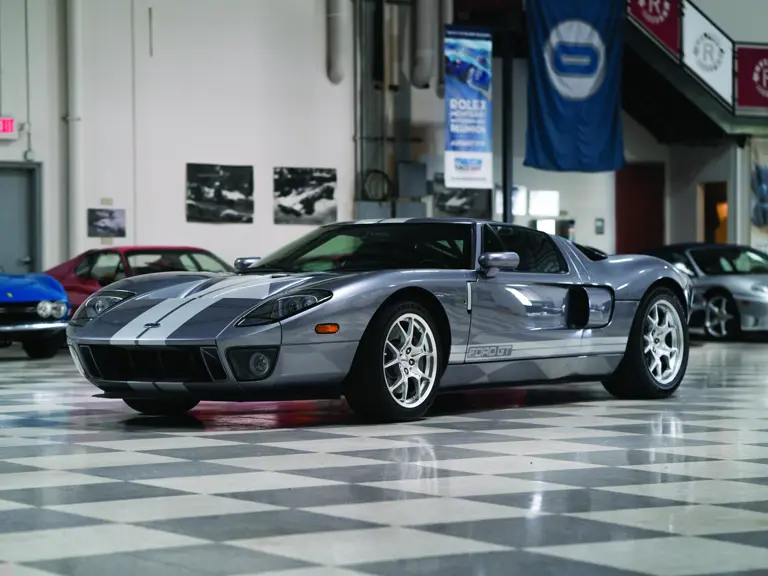
2006 Ford GT
{{lr.item.text}}
$305,250 USD | Sold
{{bidding.lot.reserveStatusFormatted}}
- 5.4-liter, 550-hp DOHC V-8 engine with Whipple supercharger
- Six-speed manual transaxle
- Only 2,011 Ford GT's built in 2006
- Less than 500 in this color/stripe combination
- Less than 2,000 miles on odometer
- Optional forged BBS wheel
- Optional gray calipers & MacIntosh Audio
- Copy of original sales invoice
- Overall clean & tidy presentation
Perhaps one of the most famous stories in the history of sports car racing is the story of the inception of the Ford GT 40. Enzo Ferrari was interested in selling the road-car division of his company, so he approached Ford in early 1963, and lawyers were quickly put to work on both sides of the Atlantic to draft a contract. However, upon seeing the final contract, Enzo believed that he was not given enough freedom or control with the racing section of the new company and refused to sign.
Seemingly overnight, Henry Ford II decided that if he couldn’t buy Ferrari, he would just have to beat them at their own game. Victory on the track would bring sweet, sweet revenge to Dearborn for this deal gone sour, and so it did after initial “teething” troubles that were common with state-of-the-art racecars of the era. Always fast, but at first unreliable, the GT 40 continued to receive development that culminated when Ford utterly dominated the 24 Hours of Le Mans in 1966 with three factory GT 40s sweeping the podium, led by Bruce McLaren and fellow New Zealander, Chris Amon, who shared the driving duties. Ford would repeat the victory at Le Mans in 1967, ’68 and ’69.
In the ensuing years, there were many times that Ford introduced a concept car that would be inspired by the legendary GT 40 and instill the possibility that perhaps a successor was on the table. Concepts such as the GT 70 of the 1970s and Detroit’s 1994 North American Auto Show debut of the GT 90 – with 1990s ideas for reliving the mid-engine GT 40 dream, would fascinate the motoring press. The GT 40 had been offered as a road car in period, but it was not a street car for the weak of heart and the impracticalities of being so similar to the racecar version cracked any illusions of the car being seen as a mode of transport for the black-tie evening crowd and jet-set that would be able to afford such a machine.
For the 100th anniversary of the Ford Motor Company, Ford decided to revive its legendary supercar after teasing GT 40 aficionados and the public for years. Three running prototypes were completed in time for Ford’s 100th Anniversary celebration in June 2003 and were widely regarded as being the hit of the entire weekend. The first Ford GTs reached their owners in late 2004, and it was clear that Ford had a fantastic car on their hands; one that was handedly capable of surpassing the Porsche Carrera GT and Mercedes-Benz McLaren SLR and coming perilously close to the Ferrari Enzo in terms of top speed, all for just a fraction of the cost; plus the luxuries and riding comfort that was nearly non-existent in the original GT 40 street cars was now an expected commodity in which Ford did not disappoint.
The car offered here has travelled less than 1,900 miles and represents one of only 2,011 Ford GT’s produced for the 2006 model year. It is reported by Ford Performance Group that 494 were finished in Tungsten with full stripes. These include the over-the-body racing stripes and the side Le Mans stripes. The Brembo four-wheel ventilated disc brake system was standard, but the gray calipers were an option with the same source reporting 250 full stripe Tungsten cars receiving them in 2006.
The car is extremely fast courtesy of its 5.4-liter, 550-hp DOHC V-8 engine with a Whipple supercharger that is high-tech, midship-mounted and connected to a six-speed manual transaxle featuring a limited-slip differential. With great effect, when the rear canopy is opened, the rear suspension components and engine are impressively presented.
The Ford GT features many distinctive technologies, including formed frame, aluminum body panels, roll-bonded floor panels, cap-less fuel filler system, one-piece door panels and an aluminum engine cover with a one-piece carbon fiber inner panel. Standard safety equipment includes frontal airbags, antilock brakes and a tire inflation kit in lieu of a spare tire.
Additionally, this example has the optional MacIntosh Audio and forged BBS wheels which adds another splendid visual touch. The tires are Goodyear Eagle F1; the interior is black and stated to be clean and tidy. The overall condition is commensurate with the mileage displayed with some sign of wear on the front valence from the modest miles driven. The car is accompanied by the owner’s manual, air pump, car cover and all of the prestige that shadows such a vaunted model. With a nearly identical silhouette to the original GT 40, the heritage is undeniable; it was aimed towards being an instant classic and has lived up to these expectations.


 | Santa Monica, California
| Santa Monica, California


